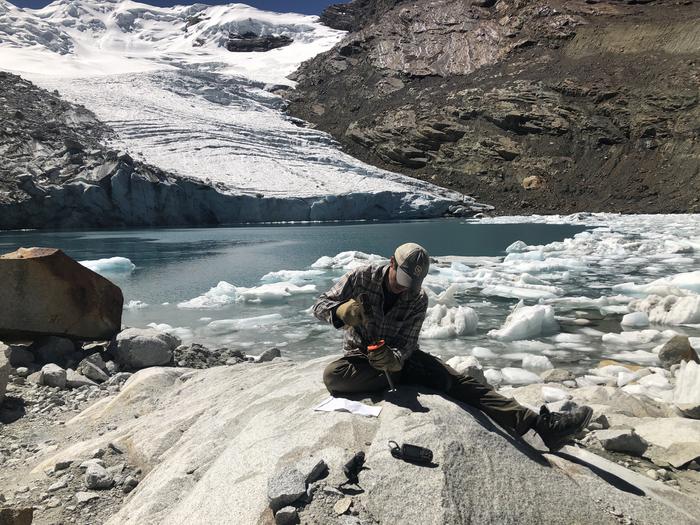Chestnut Hill, Mass (8/1/2024) – Rocks recently exposed to the sky after being covered with prehistoric ice show that tropical glaciers have shrunk to their smallest size in more than 11,700 years, revealing the tropics have already warmed past limits last seen earlier in the Holocene age, researchers from Boston College report today in the journal Science.

Credit: Emilio Mateo, Aspen Global Change Institute
Chestnut Hill, Mass (8/1/2024) – Rocks recently exposed to the sky after being covered with prehistoric ice show that tropical glaciers have shrunk to their smallest size in more than 11,700 years, revealing the tropics have already warmed past limits last seen earlier in the Holocene age, researchers from Boston College report today in the journal Science.
Scientists have predicted glaciers would melt, or retreat, as temperatures warm in the tropics – those regions bordering the Earth’s equator. But the study’s analysis of rock samples adjacent to four glaciers in the Andes Mountains shows that glacial retreat has happened far faster and already passed an alarming cross-epoch benchmark, said Boston College Associate Professor of Earth and Environmental Sciences Jeremy Shakun
“We have pretty strong evidence that these glaciers are smaller now than they have been any time in the past 11,000 years,” said Shakun, a paleoclimatologist and co-author of the report. “Given that modern glacier retreat is mostly due to rising temperatures – as opposed to less snowfall, or changes in cloud cover – our findings suggest the tropics have already warmed outside their Holocene range and into the Anthropocene.”
In other words, the glaciers may no longer be classified as being of the Holocene interglacial period, a significant epoch that saw the birth of civilization, where the flow of water and sea level dictated where towns and cities formed, and where agricultural and commercial activity emerged. Instead, they may be best classified by an epoch that may be well on its way to spelling their end: the Anthropocene.
The findings signal more of the world’s glaciers are likely retreating far faster than predicted, possibly decades ahead of a grim climatological schedule.
“This is the first large region of the planet where we have strong evidence that glaciers have crossed this important benchmark – it is a ‘canary in the coalmine’ for glaciers everywhere,” said Shakun.
Glaciers have been retreating worldwide over the past century but it has been unclear how the magnitude of this retreat compares to the range of natural fluctuations over the past several millennia, Shakun said. The team set out to determine how small tropical glaciers are today compared to their range over the last 11,000 years.
Researchers who formed the international team of scientists traveled to Colombia, Peru, and Bolivia to measure the chemistry of bedrock only recently uncovered in front of four melting glaciers spanning the tropical Andes. Two rare isotopes – beryllium-10 and carbon-14 – build up in bedrock surfaces when they are exposed to cosmic radiation from outer space, Shakun said.
“By measuring the concentrations of these isotopes in the recently exposed bedrock we can determine how much time in the past the bedrock was exposed, which tells us how often the glaciers were smaller than today – kind of like how a sunburn can tell you how long someone was out in the sun,” Shakun said.
Shakun led the project with former BC graduate student Andrew Gorin, partnering with researchers from the University of Wisconsin and Tulane University on the American Cordillera project, then seeking samples and data from colleagues at Aix-Marseille University, the National University of Ireland, Aspen Global Change Institute, Ohio State University, Union College, University Grenoble Alpes, and Purdue University.
“We found essentially no beryllium-10 or radiocarbon-14 in any of the 18 bedrock samples we measured in front of four tropical glaciers,” said Gorin, now a PhD student at UC-Berkeley. “That tells us there was never any significant prior exposure to cosmic radiation since these glaciers formed during the last ice age.”
Twenty years ago, researchers at the Quelccaya Ice Cap in Peru, the largest tropical ice mass in the world, found rooted plant remains melting out of the ice margin as it retreated. Radiocarbon dating showed that those plants were 5,000 years old, indicating Quelccaya had been larger than its size at the time of that study for that whole interval— otherwise the plants would have decayed away if there was a prior period of exposure, Shakun said.
Those Quelccaya findings suggested that modern ice retreat has been abnormally large, but was not yet progressing to an alarming level compared to ice melt across the entire Holocene, Shakun said. He and his team wanted to study a larger number of glaciers and use a technique that can unambiguously show if a glacier was ever smaller than today.
Shakun and his colleagues have been applying the same technique to glaciers along the entire length of the American Cordillera, from Alaska to Tierra del Fuego. The team previously published the results of its North American sampling last year and aims to publish the results from southern South America soon.
“Once we do that, then these studies can all be put together into a global perspective on the current state of glacier retreat,” said Shakun.
Journal
Science
Method of Research
Experimental study
Subject of Research
Not applicable
Article Title
Recent tropical Andean glacier retreat is unprecedented in the Holocene
Article Publication Date
1-Aug-2024



